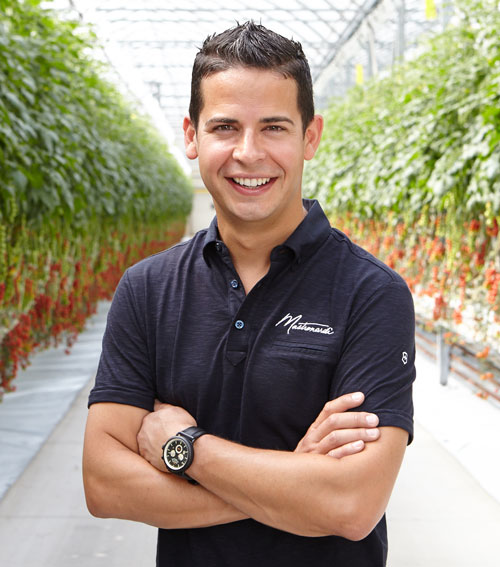Celebrating 35 Years — Vanguards Who Made a Difference: PAUL MASTRONARDI
September 13, 2022 | 7 min to read
Over the course of the year, we pay tribute to 35 living Vanguards and 12 departed heroes. This month’s featured Vanguard is Paul Mastronardi of Mastronardi Produce.
Originally printed in the October 2021 issue of Produce Business.

President/CEO
Mastronardi Produce
An innovator and front-runner in the greenhouse industry, this fourth-generation family member to lead Mastronardi Produce, is all about driving the industry’s future. With unstoppable momentum, he has infused and broadened fresh produce categories and commerce with pacesetting development. Yet he doesn’t’t rest on his laurels. His product launches regularly win prestigious awards for superior taste, unique flavor profiles, as well as branding/packaging/marketing accolades. More important, he extends and deepens category choices and uses. This expansion also relates to year-round consistent quality through the high-tech greenhouse process, all of which excites consumers to increase purchases and energize their diets and offer retailers ways to differentiate and build competitive positioning year-round.
Mastronardi takes a birds-eye view in assessing the company’s evolution and his role in helping to propel the industry forward. When asked what he would consider his top three accomplishments, without hesitation he points to industry contributions. “Definitely bringing flavor into the industry is a major one. I have been in the industry my whole life, and when I started full time in greenhouse tomatoes here, it was really about three categories of tomatoes; beefsteak, Roma and cherry, so part one for me was trying to bring flavor into the category.
In the early 90’s, people were really focused more on the product’s shipping stamina and shelf life and yields, and weren’t looking at flavor, he explains. “This is going to be shocking to most to find out, but even though I grew up in the industry, and our family grew tomatoes, peppers, cucumbers and lettuce, I was never a tomato fan. After talking to our customers and consumers I realized it wasn’t just me personally.” People were yearning for the taste they remembered, from 50 years ago or more when their grandparents used to grow them in their backyard, he says. Mastronardi started doing R&D and going around the world looking for new varietals of tomatoes. In Holland, he found a varietal the size of a golf ball, what today we’d call a cocktail variety, that he really liked for the first time in tomatoes, and knew it was a game changer.
The next problem he saw, besides discovering flavor, was how to make this different on the retail shelf so people would understand this is extraordinary. “I thought, amazingly in the produce segment there wasn’t very many brands. What we need to do is brand this tomato to make it standout.” That was the first time a tomato on a large scale was branded, and when Mastronardi created the Compari brand, it also involved how he was packaging and marketing it. He showcased the variety in a clamshell with a description of the multiple uses, it was great not just for snacking, but you could use it for hors d’oeuvres or in a salad, bringing flavor to a dish…
“So, first flavor, second creating brand and marketing, and third, to horizontally grow and expand the berry category, just like we did with tomatoes, peppers, and cucumbers,” he says, in considering his top three accomplishments. The industry certainly has benefitted from them, and his influences are celebrated and transforming.
In the tomato space, there are dozens of brands, and consumers can pick up multiple tomatoes in a single shop. Those include award-winning varieties under Mastronardi’s Sunset brand, including Splendito, the first greenhouse-grown grape tomato, and from the Bombs lineup of on-the-vine snacking tomatoes.
Another product line Sprinkles micro grape tomatoes, the size of blueberries, go into three-ounce packs to put in a lunchbox or purse for on the go. Kids love that. Also, two bite mini cucumbers, both a great success in creating snacking varieties and a packaging gateway for children.
“About eight years ago, one of our harvesters discovered a cool, striped pepper among the traditional bunches of red peppers. we thought this magical plant was a fluke until a couple of years later we found another. Breeders in Europe were also experiencing this very rare occurrence in mother nature of peppers turning colors.” For the next couple of years, Mastronardi hired scouts to run down the rows looking for a striped pepper and found one, took the leaves out and created a plant to propagate these magical peppers commercially, introducing Aloha striped peppers to the market in 2017.
With similar dedication and wherewithal, Mastronardi was determined to go high-tech with berries. “For the most part berries are grown in the field, strawberries, blackberries, raspberries, blueberries, with not that much differentiation.” Everyone knows there are many varieties of apples, options distinguished with a flurry of branded varietal names, based on characteristics targeting different consumer preferences. Consumers may buy multiple apple varieties on the same shopping trip, and the same with tomatoes. “Bringing high tech greenhouse to berries allowed us to experiment with more fragile varieties, grow in all times of the year, including the middle of winter.
“A lot of experts thought I was crazy to do strawberries in a greenhouse,” says Mastronardi, frustrated by the category’s inconsistency in quality and taste. After several years of experimentation and product development, things have taken off. Now over the past three-plus years, the company has integrated three unique, different tasting strawberries the same time of year on the same shelf side by side; under the WOW berries brand, pearberry has hints of pear and tart apple, lolliberry has low acidity, high sugar, and dreamberry is an everyday strawberry with a balance of acidity and sweetness, he explains.
People viewed success in the berry category in a more limited way, according to Mastronardi. “If a consumer picked up a pack of raspberries and a pack of strawberries that was a win, and everyone focused on supplying the pipeline. The category of berries was growing fast, and the industry had difficulty filling the pipeline. Why not differentiate when the market becomes saturated? Why not offer consumers different tastes for different preferences and uses; kids like different varieties than adults, just like consumers buy Granny Smith and Honey Crisp…
This helps retailers fill two major needs, to differentiate from other retailers, and put exciting flavors on the shelf. A lot of consumers choose where they shop by the produce department, price is an element, but they care about flavor and quality of produce first, and second how do I get berries in hard times of production, November to May. Retailers can supply the gaps and offer consumers dream berries, building sales, profits, and loyalty.
With Mastronardi, a new flavor variety, packaging innovation, or technology advancement is just around the corner or brewing in the R&D pipeline. Mastronardi’s commitment to improve the industry and help it prosper holistically is grounded in his family DNA, and industry firsts.
Mastronardi Produce is a vertically integrated company, with farming roots going back to Italy. “My great grandfather, Armando, immigrated to North America in the 1920’s, to hometown Leamington, Ontario, where he purchased his own farm. My grandfather, Umberto, who learned of greenhouse technology on a trip to Holland, pioneered the first commercial greenhouse in North America in the 1940’s. My grandfather sponsored growers and sold their product. We have partners going back many decades, and why this is so big here, and the core in the company’s North American business,” he says, adding, “We own the growing, distribution, sales and marketing and research.”
Paul’s father, Don Mastronardi, built the first 50-acre, super greenhouse operation in North America in 1994. Following in his father’s footsteps, this Vanguard has been a leader in accelerating its growth and taking the industry to new places.
The scope of the operation spans 5,000 acres of greenhouse growing capacity across Canada, the U.S. and Mexico. The company owns seven greenhouses and six distribution centers and has hundreds of growing partners that grow its exclusive proprietary varieties.
On the foodservice side, Mastronardi has worked closely with a lot of companies starting to come into the greenhouse supply space. For the most part, 90 percent of foodservice is supplied by field farms, says Mastronardi.
“We continually adapt and improve our technology and get better and better at being more efficient. The greenhouse industry uses up to 1/20th the land of field farming, and is a more resourceful way of farming,” he says, noting it’s good for employees not having to move from field to field every week, and workers don’t have to bend over for waist high harvesting, as well as cutting out food miles, and product can be more nutritional too, he says.
Greenhouse production allows you to control more of the vectors that can cause problems, he says, describing challenges with open field contamination points, and less predictability. As the industry faces scarcities in land and water resources, and climate change, and supply chain labor and logistics problems, etc., Mastronardi sees greenhouses and real high tech ag as the industry’s future. The industry is fortunate to have Mastronardi help drive that future.

